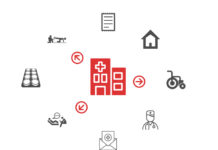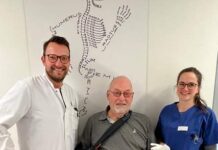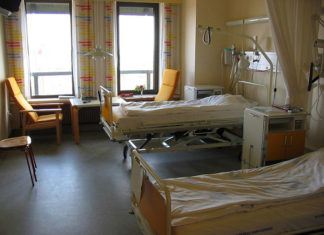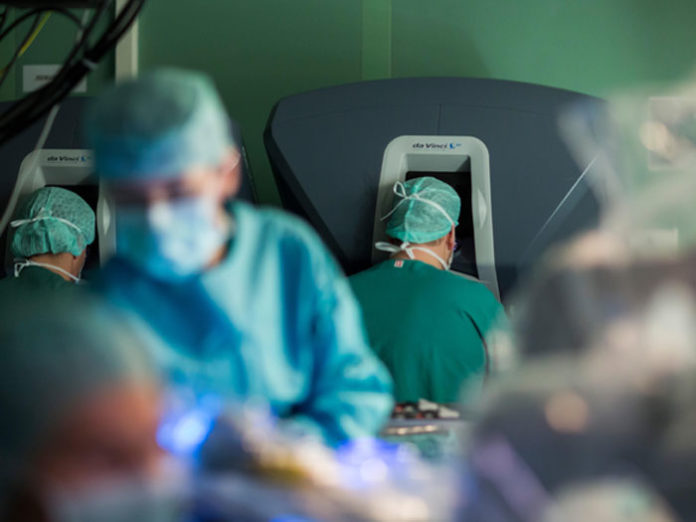
More than 100 German clinics already work with the surgical robot da Vinci. The use of the robot offers many advantages, however, it doesn’t represent a revolution to prostate surgery.

The da Vinci Surgical System consists of a control panel which the surgeon uses to steer the four robotic arms and the video tower. Thanks to the three-dimensional camera and the light technology, the surgeon gets an enlarged 3D-image of the surgical area and is able to detect even fine structures such as nerves and vessels. By moving his hands, the surgeon controls the robotic arms and the seven degrees of freedom of the robot in real time. Thus, the da Vinci robot cannot carry out any movements on its own. “This is an assistance system with a master-slave function which de facto constitutes an extension of our operating arm”, says Prof. Dr. Andreas Pascher, head of the clinic for general, abdominal and transplant surgery at the Münster University Hospital.
A surgery performed by the Da Vinci robot costs 2,000 Euros
Da Vinci robotics offers benefits for the patient: less blood loss, faster wound healing and a single external incision with a size of 2 centimeters maximum. However, there are also disadvantages. It is for example possible that the gas (CO2) which is led into the abdomen before surgery only escapes slowly over several weeks after surgery. In addition, surgery with Da Vinci is at the patient’s expense in certain clinics. In the Martini Clinic Hamburg for example, patients have to pay an additional 2,000 euros if they wish to be operated with the Da Vinci robot.
There is a reason for these costs. Different long-term studies have shown that there is no difference between surgery with the surgical robot and without in the long term. The most recent study has been conducted by Martini Clinic Hamburg which has already been mentioned. The biggest number of prostate cancer patients worldwide are treated there. 10,790 men have been surveyed between 2008 and 2016. The results: It doesn’t make a difference whether there is a robot in the operating room. What is much more important is the surgeon’s experience.
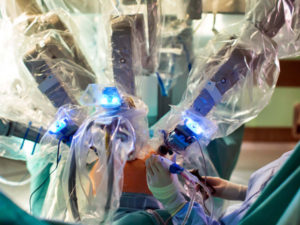
Therefore, it is important to consider carefully whether a surgery with the da Vinci robot is necessary or whether the intervention can also be performed using a laparoscopic procedure. Typical interventions with the robot such as, for example, the removal of the prostate or the implantation of the ureter, can still be carried out in the conventional manner. In each case, the doctor is obliged to discuss the different possibilities for operation and their advantages and disadvantages with the patient prior surgery. The non-compliance with this obligation constitutes a violation of applicable medical law and he can get sued.
No more back pain for doctors
Da Vinci robotics offers advantages and disadvantages not only for the patients. The same goes for the doctors. A disadvantage which applies especially to the medical staff is the time factor. The sterilization of the robotic instruments represents a greater effort for the nurses. Furthermore, the operation takes longer than an open surgery. In addition, the surgeon requires more time to prepare. Usually, more than 50 hours of simulation are required before the surgeons start their individual training.
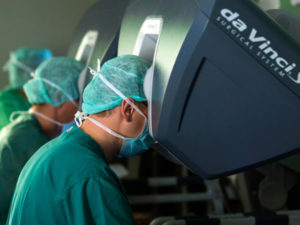
The improved overview and more precise control of the instruments is of advantage for the surgeon: Thanks to the improved image technology, organs and instruments can be displayed enlarged and in 3D. Furthermore, the robot with its angled tools and seven degrees of freedom is significantly more precise than the surgeon who merely works with his hands. Additionally, less physical effort is required which prevents neck and back pain after long surgeries. Another advantage which Dr. Hölzen observed during practical work with the da Vinci robot is the enhanced team play. As all the participants can follow the operation, further steps such as the preparation of instruments can be anticipated more quickly. Also, now not only assistants but all participants can provide guidance. “By using da Vinci, we act stronger as a team, which is a huge advantage”, says Dr. Hölzen.
The robot has long been a part of the team
Treatment using da Vinci Surgical System is not new. It is used in every big hospital in Germany. What is clear is that the da Vinci robot is only a very intelligent tool for the surgeon which does not make any decisions on its own. The surgeon has the upper ahnd for every cut.
In 2012, the Italian filmmaker Yuri Ancarani realized the artistic documentary “Da Vinci” about a surgery with the da Vinci Surgical System.
All pictures: ©Münster University Medicine















